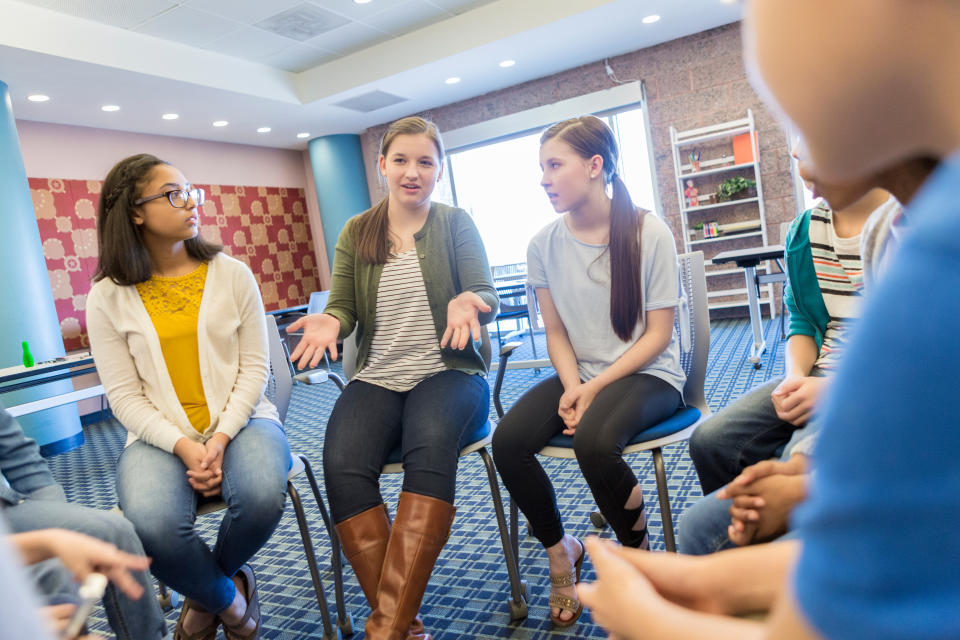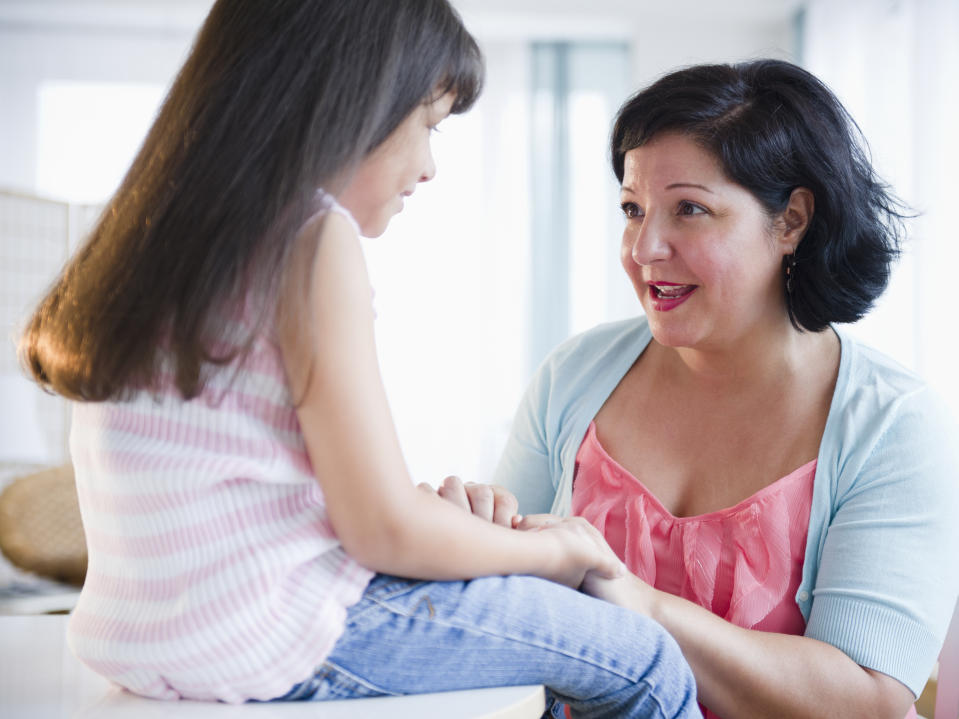Parenting during the pediatric anxiety epidemic

Editor’s note: In October 2018 Yahoo Canada published a series on anxiety, which is currently the leading mental health issue in Canada. We’re re-running several stories for Bell Let’s Talk Day to help raise awareness and funds for mental health initiatives across Canada.
Feeling anxious is completely normal. In fact, it’s a good thing. Regardless of your age, anxiety is the body’s way of keeping us alert and safe.
Although it may be difficult for children to understand, anxious feelings are supposed to come and go. It’s how we know to look both ways before we cross the street, it motivates us to practice before we play a sport and reminds us to study before taking a big test.
However, like adults, some children live in a constant state of anxiety. Many young people experience debilitating fear that severely impacts their ability to perform simple tasks like going to school or attending a birthday party.
Anxiety disorders have officially become the no. 1 reported mental health issue for children and youth in both Canada and the United States.
With more young people than ever before reporting feelings of psychological distress, anxiety is not only negatively impacting child development, but disrupting and putting strain on the family unit as a whole. According to Dr. Kathryn Boger, PhD, ABPP we are currently in the middle of what has been referred to as a pediatric anxiety epidemic.

“We’re seeing increased rates of diagnosable anxiety in children, adolescents and the college-aged population,” Boger explains. “These are children and adolescents whose anxiety is so severe they have stopped doing what they love, the things that are meaningful to them and give their lives value.”
According to Boger, feelings of anxiety and panic cause many young people to stop socializing with family and friends, to give up their extracurriculars, and to develop avoidant behaviours to minimize feelings of stress.
As the program director of the McLean Anxiety Mastery Program (MAMP) at the McLean Hospital in Cambridge, Mass., Boger leads an outpatient program that specializes in treating children ages 7-19 with anxiety disorders such as social anxiety, panic disorder, agoraphobia and separation anxiety.
“A lot of the kids in our program will stop going to school because of anxiety, and if they’re in school, they’re often unable to access their education because they’re spending much of their time distracted by anxiety.” Boger explains. “These children are falling off the developmental curve, and many children and families are in crisis by the time they come to us.”
ALSO SEE: How does religion impact anxiety?
Despite reports that one in 10 Canadian youth develop an anxiety or mood disorder, 75 per cent of children affected do not access specialized treatment for mental health issues – and the reasons why are complicated.
While it’s common for young children and adolescents to experience tantrums or mood swings, many parents may be unaware that their child may actually be struggling with anxiety.

“Anxiety can manifest in different ways, including fight, flight or freeze,” Boger explains. “You may have a ‘fight’ kid who looks obstinate or irritable and is lashing out but inside, is riddled with anxiety and is feeling very misunderstood. Sometimes, there’s a ‘flight’ kid who is avoidant, and may appear to others as lazy or like they don’t care – when in reality, anxiety is the root of the issue.”
For those who do seek help, Boger says it can be difficult for parents to navigate the system, and find treatment for their child that is effective and supported by research.
“Many anxious children and adolescents end up in talk therapy or therapy that isn’t evidence based,” she said. “These kids sometimes end up feeling even more hopeless because they’ve been in therapy for two years and think, ‘I’m still not getting better – what’s wrong with me?’”
Cognitive Behavioural Therapy (CBT), the cornerstone of treatment at MAMP, is a form of therapy that helps patients better manage anxiety by targeting their unhelpful thoughts and avoidant behaviours. Boger suggests that parents who are seeking evidence-based treatment for their children ask prospective care providers the theoretical orientation of their practice. CBT for anxiety should be goal- oriented and involve skill-building. There typically should be a cognitive and an exposure component and homework should be assigned outside of sessions.
ALSO SEE: Are millennials really the anxiety generation?
Instead of weekly therapy sessions, MAMP offers intensive two and a half hour CBT sessions with patients four times a week, which helps build trust between the patient and provider as well as momentum in treatment. The goal for MAMP is to treat young patients intensively, giving them coping skills and strategies to use in their everyday environments.
Having crossed over into anxiety epidemic territory, many parents are often left to wonder what could have caused their child to develop a disorder. Is it genetics? Family trauma? According to Boger, sometimes there isn’t one ‘why.’
“It doesn’t necessarily have to be a major life event,” Boger says. “For example, the transition to kindergarten or middle school can spark anxiety. Factors like biology, temperament, life experience, thinking patterns – all of these things can contribute to the development of anxiety. With CBT, we recognize that kids are stuck in a hole, and we’re focused on getting them out – and ensuring that they don’t fall back in.”

With more teens reporting spending upwards of three hours a day dedicated to screen time, it’s hard not to factor social media into the conversation about millennial and Generation Z’s mental health.
“Many children are over-programmed and over-scheduled these days,” Boger explains. “That, in combination with all the amount of time children spend in front of devices, can result in less down-time for the brain. It used to be that kids had opportunities to feel bored and that wasn’t a bad thing. There’s also more awareness of sensationalized world events these days. If a teen carries around a cellphone, he or she will get news pop-ups throughout the day announcing scary things that are happening around the world.”
Additionally, the pressure parents feel to be a ‘good parent’ could actually be setting our kids up for failure. Instead of micromanaging children’s activities, Boger suggests parents refrain from jumping immediately into ‘rescue or control mode.’ and give their children the opportunity to develop a sense of resiliency, and the skills to cope with challenges and their perceived failures.
ALSO SEE: Is anxiety curable? Why that’s the wrong question to ask
“Parents of high-schoolers can fall into the habit of setting up all of their children’s appointments, co-writing their papers and heavily assisting with nightly homework. These teens may manage to make it through high school and then they go off to college and they have trouble managing on their own because there’s never been the longer leash to make mistakes,” Boger says. “They haven’t had the opportunity to schedule the appointment and miss it – and they struggle when they’re on their own two feet.”
Parenting a child with anxiety can be challenging and emotionally exhausting. At MAMP, supporting the parents of young patients and equipping them with the tools to manage their child’s anxiety are critical components in the treatment process.
“Often times parents are at their wits end – they’ve tried everything from begging, to bribing and cajoling and nothing is working,” Dr. Boger says. “We like to tell parents to take the approach of empathizing and encouraging: empathize with your child’s feelings and then encourage them to move forward and slowly start facing the things that are challenging for them.

Early intervention for children with anxiety disorders is imperative to ensuring children stay on track developmentally. If left untreated, not only will grades and interpersonal skills likely suffer, but there is also an increased risk of developing further mental health issues in adulthood.
According to one study, children with anxiety disorders were 3.5 times as likely to develop depression in adulthood.
Further troubling is the evidential link between alcohol and illicit drug abuse and people with mental health disorders. Research shows that adolescent girls with anxiety disorders are at an increased risk of developing a secondary substance abuse disorder (drugs and or alcohol), particularly girls who suffer from social anxiety disorder and obsessive compulsive disorder.
Despite the statistics, a child’s fate is not sealed by an anxiety disorder diagnosis. The sooner we recognize that youth are in crisis, the sooner we can begin to support those in need with the tools to succeed.
“We know that anxiety is the most treatable psychiatric disorder. The good news is that when you have the right combination of evidence based therapy, plus medication on board (when needed), children can really get better and thrive.”
During the month of October, Yahoo Canada is delving into anxiety and why it’s so prevalent among Canadians. Read more content from our multi-part series here.
Let us know what you think by commenting below and tweeting @YahooStyleCA and follow us on Twitter and Instagram.
Abacus Data, a market research firm based in Ottawa, conducted a survey for Yahoo Canada to test public attitudes towards anxiety as a medical condition, including social stigmas and cultural impacts. The study was an online survey of 1,500 Canadians residents, age 18 and over, who responded between Aug. 21 to Sept. 2, 2019. A random sample of panelists were invited to complete the survey from a set of partner panels based on the Lucid exchange platform. The margin of error for a comparable probability-based random sample of the same size is +/- 2.53%, 19 times out of 20. The data was weighted according to census data to ensure the sample matched Canada’s population according to age, gender, educational attainment, and region.



